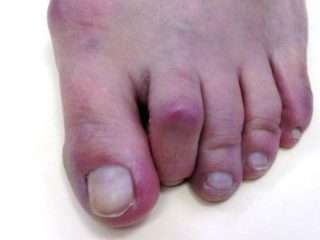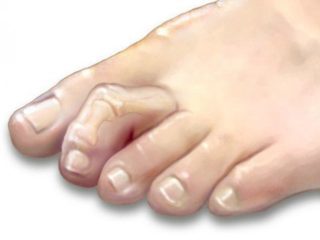Hammer Toes
The Problem
 A hammer toe is a deformity that causes your toe to bend or curl downward instead of pointing forward. This deformity can affect any toe on your foot. It most often affects the second or third toe. Although a hammer toe may be present at birth, it usually develops over time due to wearing ill-fitting shoes, such as tight, pointed heels, or arthritis. In most cases, a hammer toe condition is treatable. But if left untreated, hammertoes can become more rigid and will not respond to nonsurgical treatment.
A hammer toe is a deformity that causes your toe to bend or curl downward instead of pointing forward. This deformity can affect any toe on your foot. It most often affects the second or third toe. Although a hammer toe may be present at birth, it usually develops over time due to wearing ill-fitting shoes, such as tight, pointed heels, or arthritis. In most cases, a hammer toe condition is treatable. But if left untreated, hammertoes can become more rigid and will not respond to nonsurgical treatment.
Because of the progressive nature of hammertoes, they should receive early attention.
Certain risk factors increase your likelihood of developing a hammer toe. These include:
- A family history of hammer toe
- Chronically wearing tight or pointy-toed shoes
- Having calluses, bunions, or corns, which are thickened layers of skin caused by prolonged and repeated friction
- Trauma, an injury in which you stub, jam or break a toe can make it more likely for that digit to develop hammertoe or mallet toe.
Wearing shoes that are too small can force the joint of your toes into a dislocated position. This makes it impossible for your muscles to stretch out. Over time, the practice of wearing improperly fitting shoes increases your risk of developing:
- Hammer toes
- Blisters
- Bunions
- Corns
Treatment
 There is a variety of treatment options for hammertoe. The treatment will depend on the severity of your hammertoe and other factors.
There is a variety of treatment options for hammertoe. The treatment will depend on the severity of your hammertoe and other factors.
Nonsurgical treatment can be undertaken:
- Changes in shoewear. Avoid shoes with pointed toes, shoes that are too short, or shoes with high heels—conditions that can force your toe against the front of the shoe. Instead, choose comfortable shoes with a deep, roomy toebox and heels no higher than two inches.
- Orthotic devices. A custom orthotic device placed in your shoe may help control the muscle/tendon imbalance.
- Injection therapy. Corticosteroid injections are sometimes used to ease pain and inflammation caused by hammertoe.
- Oral nonsteroidal anti-inflammatory drugs (NSAIDs), such as ibuprofen, may be recommended to reduce pain and inflammation. Splinting/strapping. Splints or small straps may be applied by the surgeon to realign the bent toe.
Surgical Treatment
If conservative treatments don’t help, when the hammer toe has become more rigid and painful or when an open sore has developed, surgery is needed. To release the tendon that’s preventing your toe from lying flat. In some cases, the surgeon also might remove a piece of bone to straighten your toe.


